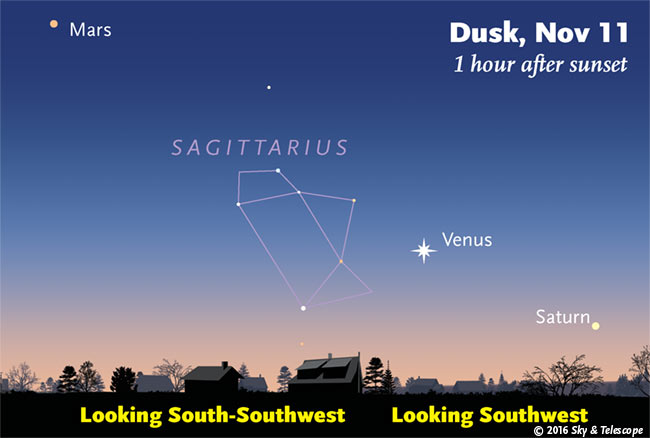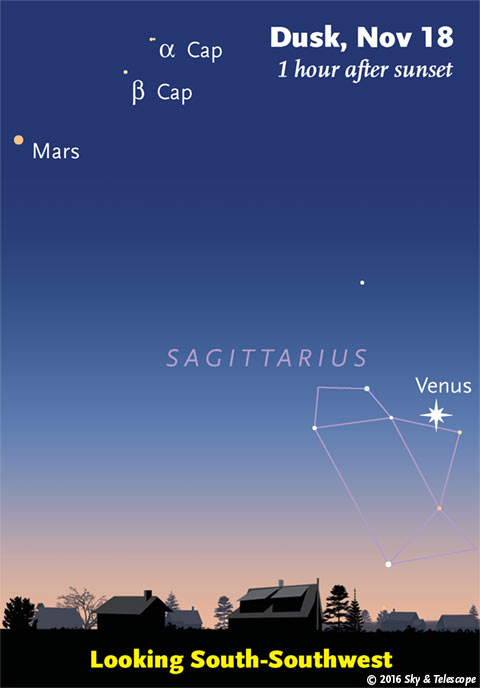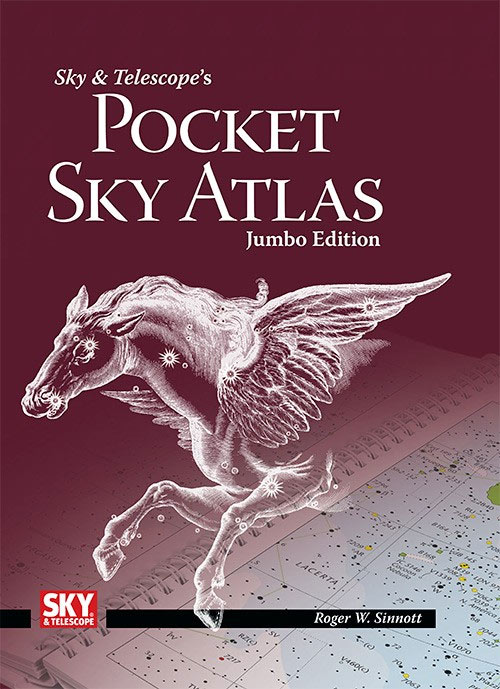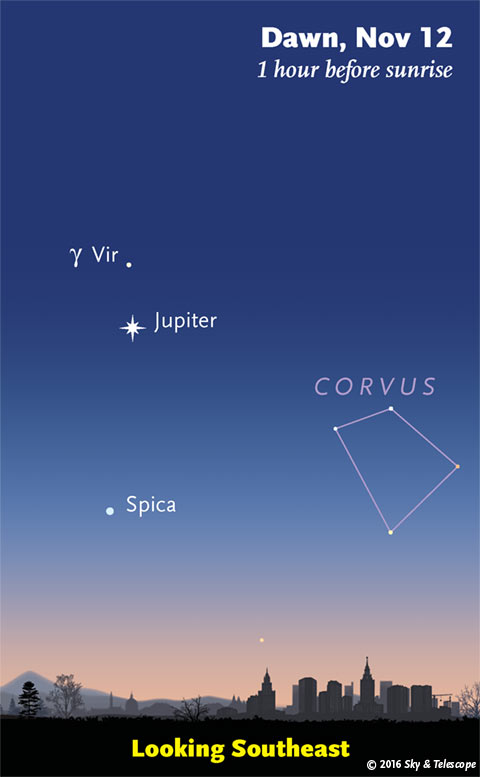
Friday, November 11
• Saturn is falling ever farther away to the lower right of Venus at dusk. Far to Venus's upper left, Mars is drawing closer to it — very gradually.
• Orion is clearing the eastern horizon by about 8 p.m. now, depending on how far east or west you live in your time zone. High above Orion shines orange Aldebaran. Above Aldebaran is the little Pleiades cluster, the size of your fingertip at arm's length. Far left of the Pleiades is bright Capella.
Saturday, November 12
• The waxing gibbous Moon shines in the southeast this evening. Upper left of it by about 15° are the two or three leading stars of Aries. About the same distance lower left of the Moon is Menkar, Alpha Ceti, the only brightish star (magnitude 2.5) in Cetus's head.
Sunday, November 13
• Full Moon tonight and tomorrow. The Moon is exactly full at 8:52 a.m. Eastern Standard Time Monday morning, splitting the difference between Sunday and Monday evenings.
• And yes, this is a record-breaking full "supermoon," by just a little bit. Can you really detect its difference from an average Moon? For a way to do this, see “Supermoons”: A Unique Observing Challenge.
Monday, November 14
• Another night of full supermoon; see above. Look for Aldebaran to its lower left. And can you see the Pleiades to its upper right, through the supermoonlight?
Tuesday, November 15
• The Moon, just past full, has now stepped to the lower left of Aldebaran (as seen in the evening).
Wednesday, November 16
• Vega is the brightest star in the west early on November evenings. Vega's little constellation Lyra extends to its left, pointing in the direction of Altair, the brightest star in the southwest.
Thursday, November 17
• Look carefully at Venus as twilight ends. This evening it's only ½° from 3rd-magnitude Lambda Sagittarii, the lid star of the Sagittarius Teapot.

Friday, November 18
• Around 8 or 9 p.m. this week, the Great Square of Pegasus stands in its level position very high toward the south. (It's straight overhead if you're as far south as Miami.) Its right (western) side points very far down toward Fomalhaut. Its eastern side points down less directly toward Beta Ceti, not as far down.
If you have a very good view down to a dark south horizon — and if you're not much farther north than roughly New York, Denver, or Madrid — picture an equilateral triangle with Fomalhaut and Beta Ceti forming its top two corners. Near where the third corner would be is Alpha Phoenicis, or Ankaa, in the constellation Phoenix. It's magnitude 2.4, not very bright but the brightest thing in its area. It has an orange tint (binoculars help). Have you ever seen anything of the constellation Phoenix before?
Saturday, November 19
• Pulsing stars in Cepheus: High overhead, follow the naked-eye changes of famous Delta Cephei, and the telescopic changes of obscure T Cephei, using the charts and article in the November Sky & Telescope, page 48.
_________________________
Want to become a better astronomer? Learn your way around the constellations! They're the key to locating everything fainter and deeper to hunt with binoculars or a telescope.
This is an outdoor nature hobby. For an easy-to-use constellation guide covering the whole evening sky, use the big monthly map in the center of each issue of Sky & Telescope, the essential guide to astronomy.

Once you get a telescope, to put it to good use you'll need a detailed, large-scale sky atlas (set of charts). The basic standard is the Pocket Sky Atlas (in either the original or new Jumbo Edition), which shows stars to magnitude 7.6.
Next up is the larger and deeper Sky Atlas 2000.0, plotting stars to magnitude 8.5, nearly three times as many. The next up, once you know your way around, is the even larger Uranometria 2000.0 (stars to magnitude 9.75). And read how to use sky charts with a telescope.
You'll also want a good deep-sky guidebook, such as Sue French's Deep-Sky Wonders collection (which includes its own charts), Sky Atlas 2000.0 Companion by Strong and Sinnott, or the bigger Night Sky Observer's Guide by Kepple and Sanner.
Can a computerized telescope replace charts? Not for beginners, I don't think, and not on mounts and tripods that are less than top-quality mechanically (meaning heavy and expensive). And as Terence Dickinson and Alan Dyer say in their Backyard Astronomer's Guide, "A full appreciation of the universe cannot come without developing the skills to find things in the sky and understanding how the sky works. This knowledge comes only by spending time under the stars with star maps in hand."
This Week's Planet Roundup

Mercury is buried deep in the glare of sunset.
Venus (magnitude –4.1) shines brightly as the "Evening Star" in the southwest during and after twilight.
Mars (magnitude +0.5) still glows in the south-southwest at dusk, about 30° upper left of Venus as seen at the top of this page. In a telescope, Mars has shrunk to a mere 7 arcseconds in diameter.
Jupiter (magnitude –1.7) shines brightly in the east-southeast before and during dawn, as shown here. Look for Spica about 11° under it.
Saturn (magnitude +0.5) glimmers low in the southwest, well to the lower right of Venus as evening twilight fades.
Uranus (magnitude 5.7, in Pisces) and Neptune (magnitude 7.9, in Aquarius) are high in the southeast and south, respectively, in early evening. Info and finder charts.
__________________________
All descriptions that relate to your horizon — including the words up, down, right, and left — are written for the world's mid-northern latitudes. Descriptions that also depend on longitude (mainly Moon positions) are for North America.
Eastern Standard Time (EST) is Universal Time (UT, UTC, or GMT) minus 5 hours.
__________________________
"This adventure is made possible by generations of searchers strictly adhering to a simple set of rules. Test ideas by experiments and observations. Build on those ideas that pass the test. Reject the ones that fail. Follow the evidence wherever it leads, and question everything. Accept these terms, and the cosmos is yours."
— Neil deGrasse Tyson
 1
1








Comments
November 11, 2016 at 3:53 pm
The Western side of the Great Square of Pegasus also points up to Polaris. The two stars on that side are almost exactly opposite in the sky (12 hrs in Right Ascension) from The Pointers in the Big Dipper.
You must be logged in to post a comment.
You must be logged in to post a comment.